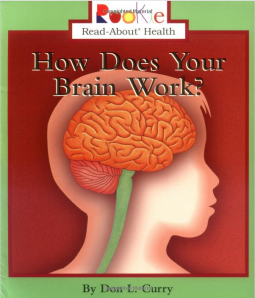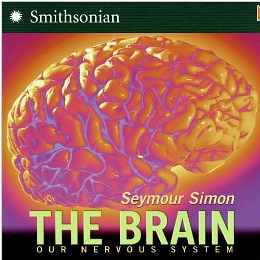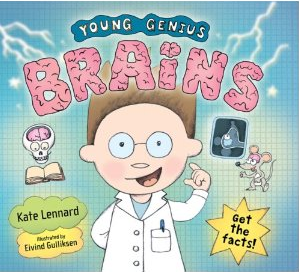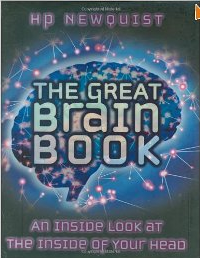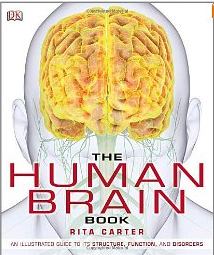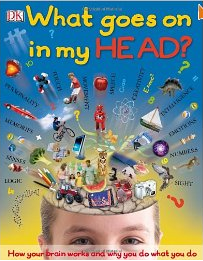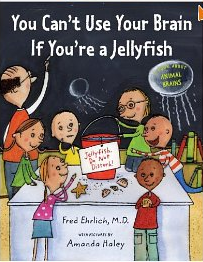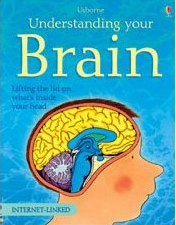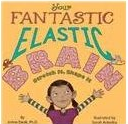 Here are some great books that we use to teach kids about the brain in preparation for Healthy Brain/Screentime Turnoff Week. In first through fifth grades we use the Smartboard with pictures, info, and links to video and animations that show the brain, healthy and unhealthy neurons, and how neurotransmission works. We also use these books, and would use them more extensively in class councils if we didn’t have the Smartboard. In kindergarten we use the brain model and a brain-hat activity. In first grade we use the brain model, brain hat activity, the Smartboard, and the book How Does Your Brain Work? by Don L. Curry, which provides a good introduction to the brain.
Here are some great books that we use to teach kids about the brain in preparation for Healthy Brain/Screentime Turnoff Week. In first through fifth grades we use the Smartboard with pictures, info, and links to video and animations that show the brain, healthy and unhealthy neurons, and how neurotransmission works. We also use these books, and would use them more extensively in class councils if we didn’t have the Smartboard. In kindergarten we use the brain model and a brain-hat activity. In first grade we use the brain model, brain hat activity, the Smartboard, and the book How Does Your Brain Work? by Don L. Curry, which provides a good introduction to the brain.
Here are some other great books that we read with kids or have available for them to read and look at on their own:
The Brain: Our Nervous System by Seymour Simon has some fabulous photos of the brain, neurons, neurotransmission, and MRI, PET, and SPECT scans, along with lots of good information. You can use the pictures with all grade levels, but the text is more appropriate for fourth grade and up.
Young Genius: Brains by Kate Lennard provides a great introduction to young children and is appropriate for kids as young as kindergartners. It contains facts, jokes, pictures, and some fun to use flaps. Here’s the description from the back cover of the book:
Hello! I’m Young Genius.
This book is about the amazing machine inside your head called your brain. I’m here to tell you all about it . . .
This hugely funny book covers everything you need to know about brains, such as:
How can you look at your brain without taking it out of your head?
Where do headaches come from?
What is imagination?
With vibrant illustrations and easy-to-understand text, this is a must-have book for budding brain surgeons!
Your child can be a Young Genius, too, with this fun-filled fact-packed book!
The Great Brain Book: An Inside Look at the Inside of Your Head by H.P. Newquist is full of information including brain structures, neurons and neurotransmission, the history of neuroscience, the thinking brain, the emotional brain, brain treatments, and the future of the brain. This book is comprehensive, with lots of text that is appropriate for solid readers in fourth grade and up. There are lots of great pictures that are appropriate for everyone.
The DK book The Human Brain Book: An Illustrated Guide to its Structure, Function, and Disorders by Rita Carter is an excellent, comprehensive book with fabulous illustrations and a CD with additional resources. The text is too hard for all but the highest elementary readers, but our kids love looking at the pictures and reading the topics that are most interesting to them.
A DK book designed for kids is What Goes On in My HEAD: How Your Brain Works and Why You Do What You Do by Robert Winston. It has a great layout with tons of pictures and is packed full of information. Kids LOVE to browse through it. The text is most appropriate for grades three and up, but the pictures are for everyone.
You Can’t Use Your Brain if You’re a Jellyfish by Fred Ehrlich, M.D. is about all kinds of brains — insect, bird, dog, cat, monkey, and human — but not about jellyfish brains, because they don’t have brains! This book has great pictures and informative, sometimes funny text, and is suitable for grades two and up.
Understanding Your Brain: Lifting the Lid on What’s Inside Your Head by Rebecca Treays has lots of great info, pictures, puzzles, and links to web resources. Its text is appropriate for third grade and up.
I haven’t been able to get my hands on a copy of Your Fantastic, Elastic Brain: Stretch It, Shape It by JoAnn Deak, but this video preview made me really want it.
[youtube=http://www.youtube.com/watch?v=ch3kbXBah5Y&feature=player_embedded]
Here’s the cover of the book:
Do you have any other great brain books to recommend? I’d love to hear about them!

